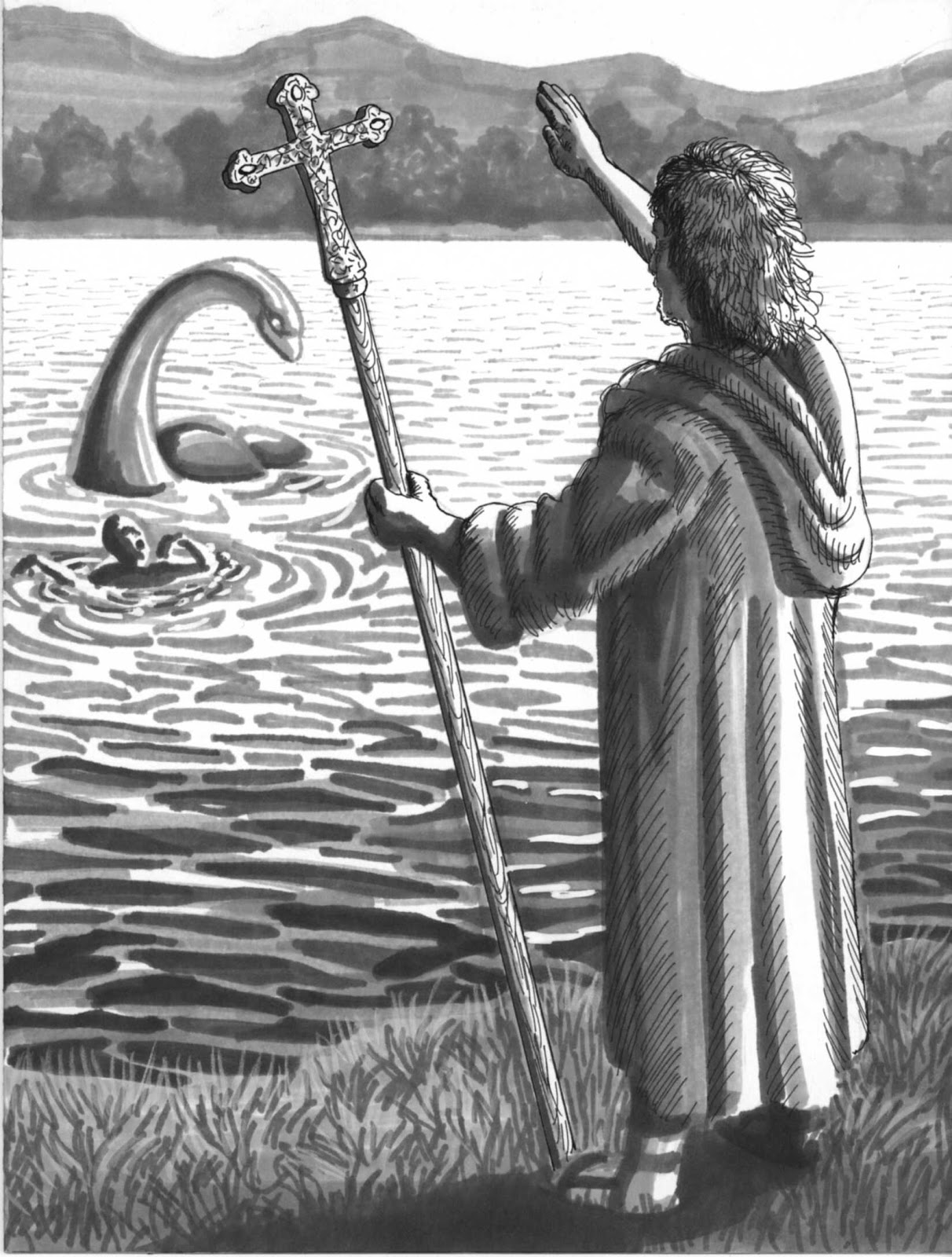0565: St. Columba and the Beast in the River Ness
There is a legend that claims the first reported sighting of what would later be known as the 'Loch Ness Monster' in Loch Ness, Scotland, was made by Saint Columba [521-597 CE], which is considered proof of the continuing existence of a large unidentified animal (or animals) in Loch Ness for over a 1400 year period previous to the modern sightings, adding authenticity to current reports of an unknown creature in the lake.
 A somewhat fantastic version of the believed occurrence [Larger version here]
A somewhat fantastic version of the believed occurrence [Larger version here]
If only things were that simple. There are problems that must be considered, and objections that must be heard regarding these claims... but first, it must be acknowledged that St. Columba was in fact recorded as having encountered a strange creature in the waters of Scotland in the year 565 CE. So let's start with the legend, taken from an 1874 translation of Vita Columbae (The Life of St. Columba), written by Adamnan [624-704 CE]. The story runs thus:
"On another occasion also, when the blessed man was living for some days in the province of the Picts, he was obliged to cross the river Nesa (the Ness); and when he reached the bank of the river, he saw some of the inhabitants burying an unfortunate man, who, according to the account of those who were burying him, was a short time before seized, as he was swimming, and bitten most severely by a monster that lived in the water; his wretched body was, though too late, taken out with a hook, by those who came to his assistance in a boat. The blessed man, on hearing this, was so far from being dismayed, that he directed one of his companions to swim over and row across the coble that was moored at the farther bank. And Lugne Mocumin hearing the command of the excellent man, obeyed without the least delay, taking off all his clothes, except his tunic, and leaping into the water. But the monster, which, so far from being satiated, was only roused for more prey, was lying at the bottom of the stream, and when it felt the water disturbed above by the man swimming, suddenly rushed out, and, giving an awful roar, darted after him, with its mouth wide open, as the man swam in the middle of the stream. Then the blessed man observing this, raised his holy hand, while all the rest, brethren as well as strangers, were stupefied with terror, and, invoking the name of God, formed the saving sign of the cross in the air, and commanded the ferocious monster, saying, 'Thou shalt go no further, nor touch the man; go back with all speed.' Then at the voice of the saint, the monster was terrified, and fled more quickly than if it had been pulled back with ropes, though it had just got so near to Lugne, as he swam, that there was not more than the length of a spear-staff between the man and the beast. Then the brethren seeing that the monster had gone back, and that their comrade Lugne returned to them in the boat safe and sound, were struck with admiration, and gave glory to God in the blessed man. And even the barbarous heathens, who were present, were forced by the greatness of this miracle, which they themselves had seen, to magnify the God of the Christians."
Was It Nessie?
While many modern enthusists for the existence of the Loch Ness Monster (known familiarly as 'Nessie') point to the legend of St. Columba as the first documented sighting of said creature, they tend to miss -- or simply ignore -- two facts.
First, assuming the report can be treated as true (which is an assumption, mind you), the sighting does not take place in Loch Ness. The River Ness is an estuary at the North end of the lake, and is substantially less deep than Loch Ness. Loch Ness dumps into the ocean through the River Ness, and older sources -- mid-1800's -- state that in it's twelve mile span the river dropped around fifty feet headed towards the sea, which made for a very strong current in that direction, indeed. So whatever the creature, it would have to be smaller than the average reports for the modern suspected lake creature, and a very good swimmer. Which, incidentally, also implies Columba's man would have to have been a pretty good swimmer as well to avoid heading out to sea.
Second, the enthusists tend to ignore the lack of reports between St. Columba's encounter in 565 CE and the next set of reports around 1933 CE. St. Columba's story can only be assumed to be the first report of the same phenomena if the phenomena can be shown to have a continuity between St. Columba's report and the modern reports; but that continuity is missing, so there is no reason to believe that what St. Columba may have encountered is in anyway related to the modern reports. Where did the monster go after St. Columba visited, after all?
Further objections that come to mind is that St. Columba's report is of a man-eating creature... but no modern report includes this as even a possibility. In addition, if we assume that the monster in the legend is a fact, we must also assume that the report of St. Columba ordering it away is an equally valid fact; this is because we have the same amount of proof for both points in the story. All in all, it seems very likely that the idea of St. Columba divinely ordering the monster away is an invented part of the story to show his saintliness... in which case there is also the distinct possibility that the whole tale is an invention for that purpose.
In the positive for the story is simply the fact that it was written close enough to the original occurrence that it can be argued that Adamnan could have interviewed witnesses to the event. We don't know if he did, however.
So, in the end, St. Columba's legend needs to be treated as just that... a legend. There is not enough evidence to indicate it is either true or related to any modern reports of a large creature living in Loch Ness.
Another Tale of St. Columba and Loch Ness... maybe
Another tale about St. Comlumba that I've run across while researching the Loch Ness 'Monster' asserts that Columba gave the monster a blessing and the freedom to live in the lake for having towwed Columba and his followers from one end of Loch Ness to the other in their coracles (very small boats), against the wind. In this version, the monster is a Scottich 'water-horse', which can change its form at will; for the towing job, the monster transformed itself into an atheletic young man, tied the coracles together, changed back into a 'water-horse' (presumably horse shaped) and swam across while towing the coracles with its teeth.
The earliest I've found this odd tale is in Tim Dinsdale's book The Story of the Loch Ness Monster, first published in 1973... and, honestly, I can't tell if he just made it up or got it from someone else who made it up. I can say this: I've not been able to find any earlier mention of this tale, and it would likely have been featured in any books about St. Columba, which it hasn't. So this just looks like a new 'old' tale for right now, and shouldn't be treated as evidence for anything. Just so you know!
Anomalies -- the Strange & Unexplained, as well as my other website -- Monsters Here & There -- are supported by patrons, people like you! All new Anomalies articles are now posted for my patrons only, along with exclusive content made just for them. You can become a patron for just $1 a month!
|








